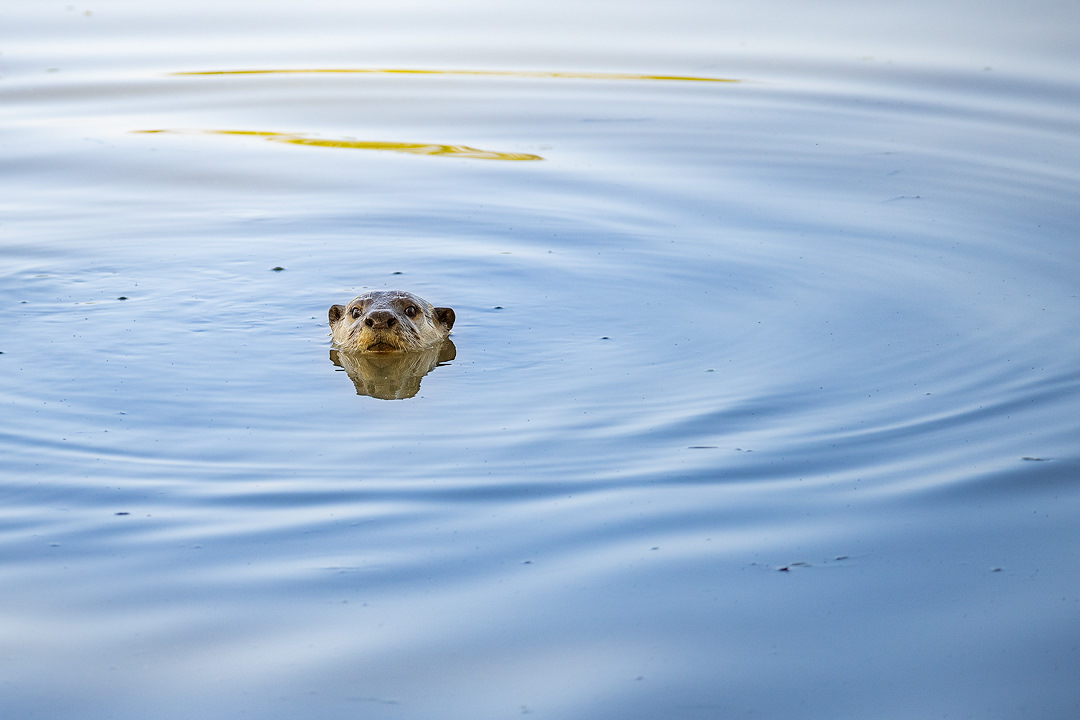Indian Smooth-Coated Otter
An Indian Smooth-Coated Otter pokes its head out of the water to give us a good look. Kaziranga National Park, Assam, India.
Indian Smooth-Coated Otters: A Charismatic Aquatic Mammal of India
The Indian Smooth-Coated Otter (Lutrogale perspicillata) is a species of otter that can be found in several countries in South and Southeast Asia, including India, Bangladesh, Nepal, and Malaysia. They are one of the largest species of otter and are well adapted to life in and around water.
Indian Smooth-Coated Otters are known for their sleek and glossy fur, which is an attractive shade of dark brown. Their fur is extremely water-repellent, which helps to keep them warm and dry while they are swimming. They have a streamlined body that is perfectly adapted to life in the water, with webbed feet and a long, tapered tail that they use as a rudder. These otters can grow up to five feet in length and weigh around 18 pounds, making them one of the largest species of otters in the world.
In the wild, Indian Smooth-Coated Otters are social animals that live in family groups. These groups can consist of up to a dozen individuals and are often led by the dominant female. The otters hunt and play together, and they are well known for their playful behavior, which includes sliding down muddy banks into the water, chasing each other around, and engaging in other fun activities.
One of the most interesting things about Indian Smooth-Coated Otters is their diet. They are omnivorous in nature, meaning they will eat almost anything they can get their paws on, including fish, crustaceans, mollusks, frogs, and even small mammals and birds. They are skilled hunters and can dive to depths of up to 10 feet in search of food.
Unfortunately, Indian Smooth-Coated Otters are a threatened species, with their populations declining due to habitat loss and fragmentation, as well as hunting for their fur and fishing activities. Conservation efforts are underway to protect these fascinating creatures and their habitats, but much more needs to be done to ensure their long-term survival.
You can find more about Smooth coated otters here.
About Kaziranga National Park:
Kaziranga National Park was first established in 1905 with the help of Mary Curzon, the wife of Viceroy Lord Curzon of Kedleston. As Vicereine of India, Mary held the highest official title in the Indian Empire that a woman could hold. It is said that when Mary visited the area to see rhinos she was unable to find even one and so persuaded her husband to take urgent measures to protect the vulnerable species. After the legislation was passed the Kaziranga Reserve Forest was created with an area of 232 km2. In 1985 Kaziranga became a UNESCO world heritage and is now one of India’s most famous tourist destinations, located on the edge of the Himalayan biodiversity hotspot in the state of Assam.
Now covering 430² km, Kaziranga is dominated by dense tropical forests, marshland and vast expanses of giant elephant grass, so called because they can grow tall enough to hide even the largest animals. The Brahmaputra river that winds it way through the flood plains is the lifeblood of the area and gives the national park its amazing biodiversity.
Kaziranga is home to the world’s largest population of Greater one-horned rhinoceros. Over 2200 rhinos inhabit the elephant grass meadows and dense forests; approximately 2/3rd of total world population. The National Park is also home to many other endemic and endangered animals such as Hoolock Gibbons; India’s only ape, Indian Elephants, Sloth Bears, Wild water buffalo and swamp deer. An increase in the tiger population every year has also meant that Kaziranga was declared as a Tiger Reserve in the 2006 and it is now purported to have the highest density of tigers anywhere in the world.
Along with the wide range of mammal species the park is also recognised as an important area for birds. Rare birds such as the ferruginous duck, lesser white-fronted goose, Baer’s pochard, adjutant storks, black-necked storks, and Asian Openbill storks migrate here from the Central Asia during the winter.
